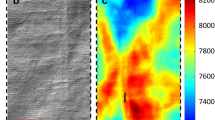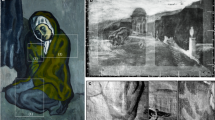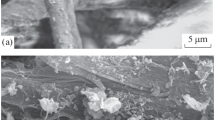Abstract
The aim of the research project “Typology of Dutch Drawing” was to establish an interdisciplinary approach for investigating heterogeneous drawing collections. To define a type common to a group of drawings, we determine elements that are common to them based on style and the use of identical materials. To that end, we investigated about 750 Dutch drawings from the sixteenth century at the Dresden Kupferstich-Kabinett using art historical and scientific methods. In this work, we present a detailed analysis of 30 drawings ascribed to the Egmont Master.
















Similar content being viewed by others
Notes
Countermarks are logos of papermakers that are as second watermarks into the paper sheet. They are completely independent of the main watermark.
References
Ketelsen T, Dietz G, Hahn O, Hoss M, Simon O, Wintermann C, Wolff T (2009) Zu einer Typologie der niederländischen Zeichnung des 16. Jahrhunderts Ein interdisziplinäres Forschungsprojekt am Kupferstich-Kabinett. Dresdner Kunstblätter 04. Deutscher Kunstverlag, Dresden, pp 281–290
Dietz G, Simon O (2005) Papiere und Wasserzeichen der frühen niederländischen Zeichnung des Dresdner Kupferstich-Kabinetts. In: Ketelsen T, Neidhardt U (eds) Das Geheimnis des Jan van Eyck. Deutscher Kunstverlag, Dresden, pp 222–227
Piccard G (1961) Kronen-Wasserzeichen. Verlag W. Kohlhammer, Stuttgart, pp 9–23
Otal H, van der Lubbe J (2009) Digitale Erkennung und Abfrage von Wasserzeichen. In: Rückert P, Hodecek S, Dietz G, Wenger E (eds) Ochsenkopf und Meerjungfrau Papiergeschichte und Wasserzeichen vom Mittelalter bis zur Neuzeit. Landesarchiv Baden-Württemberg, Hauptstaatsarchiv, Stuttgart, pp 109–112
Dietz G, van Delft M (2009) Bildaufnahmeverfahren von Wasserzeichen. Rückert P, Hodecek S, Dietz G, Wenger E (eds) Ochsenkopf und Meerjungfrau Papiergeschichte und Wasserzeichen vom Mittelalter bis zur Neuzeit. Landesarchiv Baden-Württemberg, Hauptstaatsarchiv, Stuttgart, p 67
van Staalduinen M, van der Lubbe J, Dietz G, Laurentius F, Laurentius T (2006) Comparing X-ray and backlight imaging for paper structure visualization. In: Proc Electronic Imaging and the Visual Arts (EVA) 2006, Florence, Italy, 3–7 April 2006, pp 108–113
Bronk H, Röhrs S, Bjeoumikhov A, Langhoff N, Schmalz J, Wedell R, Gorny H, Herold A, Waldschläger U (2001) ArtTAX®: a new mobile spectrometer for energy dispersive micro X-ray fluorescence spectrometry on art and archaeological objects. Fresenius J Anal Chem 371:307–316
Malzer W, Hahn O, Kanngießer B (2004) A fingerprint model for inhomogeneous ink paper layer systems measured with micro X-ray fluorescence analysis. X-Ray Spectrom 33:229–233
Niemeyer J (1964) Exhibition catalogue for the Houthakker Collection. Prentenkabinet, Amsterdam, p 26 (commentary on no. 59)
van der Sman G (1999) Observations on the Master of the Egmont Albums. In: Eiche S, van der Sman G, van Waadenoijen J (eds) Proc Symp Fiamminghi a Roma 1506–1608, Utrecht, the Netherlands, 13 March 1995, pp 45–65
Dietz G (2010) Kapitel zur Papierindustriegeschichte im Hinblick auf deren Markierungen im Papier (Ph.D. thesis). Universität Bern, Bern, p 32
Krekel C (1999) Chemische Struktur historischer Eisengallustinten. In: Banik G, Weber H (eds) Tintenfraßschäden und ihre Behandlung Werkhefte der staatlichen Archivverwaltung Baden-Württemberg Serie A Landesarchivdirektion 10. Verlag W Kohlhammer, Stuttgart, pp 25–36
Hahn O (2010) Analyses of iron gall and carbon inks by means of X-ray fluorescence analysis: a non-destructive approach in the field of archaeometry and conservation science. Restaur Intern J Preserv Libr Arch Mater 31(1):41–64
Hahn O, Malzer W, Kanngießer B, Beckhoff B (2004) Characterization of iron gall inks in historical manuscripts using X-ray fluorescence spectrometry. X-Ray Spectrom 33:234–239
Wolff T (2009) Referenzprobenfreie quantitative Mikro-Röntgenfluoreszenzanalyse (Ph.D. thesis). Technische Universität Berlin, Berlin
Wenger E, Atanasiu V (2008) Paper expertise and contextual data provided by the eContenPlus Project Bernstein. IPH Congr Book 17:93–101
Author information
Authors and Affiliations
Corresponding author
Additional information
Published in the special issue Analytical Techniques in Art, Archaeology and Conservation Science with guest editor Oliver Hahn.
Rights and permissions
About this article
Cite this article
Dietz, G., Ketelsen, T., Hoss, M. et al. The Egmont Master phenomenon: X-ray fluorescence spectrometric and paper studies for art history research. Anal Bioanal Chem 402, 1505–1515 (2012). https://doi.org/10.1007/s00216-011-5309-4
Received:
Revised:
Accepted:
Published:
Issue Date:
DOI: https://doi.org/10.1007/s00216-011-5309-4




